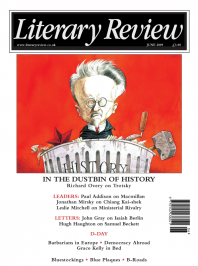Andrew Lambert
Courage Under Fire
Men of War: The Changing Face of Heroism in the 19th Century Navy
By David Crane
HarperPress 496pp £30
Men of War connects David Crane’s previous books on the Byronic world of Edward Trelawny and the icy heroism of Captain Scott, using three nineteenth-century captains to examine the meaning of heroism. The first is Frank Abney Hastings, who stipulated that his sword, suitably inscribed, should be given to an officer noted for ‘Skill and Valour’. We should remember, however, that Hastings launched a career of unending violence when he fought at Trafalgar, aged eleven. Cashiered for insubordination in 1817, he was drawn into the Greek War of Independence. Despite the horror and the madness of the conflict he stuck to the cause, commanding the world’s first steam warship, the Perseverance. Red-hot shot from her furnaces added modern mechanical brutality to a primitive, barbaric conflict. He died of an untreated minor wound in 1828, aged only thirty-four, a few months after the Battle of Navarino had secured Greek independence.
William Peel, son of the Prime Minister Sir Robert, joined the service a decade later. Clever, cultured and highly personable, young Peel had a lot to live up to, but by the age of twenty-three he had fought the Egyptians and the Chinese, sailed the South Pacific and conducted a major intelligence mission. Family connections made him the youngest captain in the navy, and the Crimean War made him a national hero. He commanded a battery at the bombardment of Sevastopol, where most of the guns, and gunners, were naval. Peel’s calm and professional style secured the admiration of generals, subalterns and hard-bitten seafarers alike. He won the VC leading the Guards at the Battle of Inkerman, and again for throwing a live shell out of his battery. Rewarded with a prize seagoing command, he fought his final battles a thousand miles from the sea, leading a naval brigade during the Indian Mutiny. Having again performed heroically he died of smallpox, beloved by all. While the Victorians reinvented him as a medieval Christian warrior, Crane suggests that Peel, a highly educated, sensitive man, consciously created his warrior persona. He helped others to be brave by showing that he was without fear. That was how he dealt with the burden of expectation placed on the son of a great man. His eldest brother was a complete failure.
James Graham Goodenough, godson of the First Lord of the Admiralty, had a head start in the Navy. Serving under Peel in the 1840s he pushed his way to the top in the Second Opium War in 1856. Although he knew how to lead and when to take

Sign Up to our newsletter
Receive free articles, highlights from the archive, news, details of prizes, and much more.@Lit_Review
Follow Literary Review on Twitter
Twitter Feed
Russia’s recent efforts to destabilise the Baltic states have increased enthusiasm for the EU in these places. With Euroscepticism growing in countries like France and Germany, @owenmatth wonders whether Europe’s salvation will come from its periphery.
Owen Matthews - Sea of Troubles
Owen Matthews: Sea of Troubles - Baltic: The Future of Europe by Oliver Moody
literaryreview.co.uk
Many laptop workers will find Vincenzo Latronico’s PERFECTION sends shivers of uncomfortable recognition down their spine. I wrote about why for @Lit_Review
https://literaryreview.co.uk/hashtag-living
An insightful review by @DanielB89913888 of In Covid’s Wake (Macedo & Lee, @PrincetonUPress).
Paraphrasing: left-leaning authors critique the Covid response using right-wing arguments. A fascinating read.
via @Lit_Review